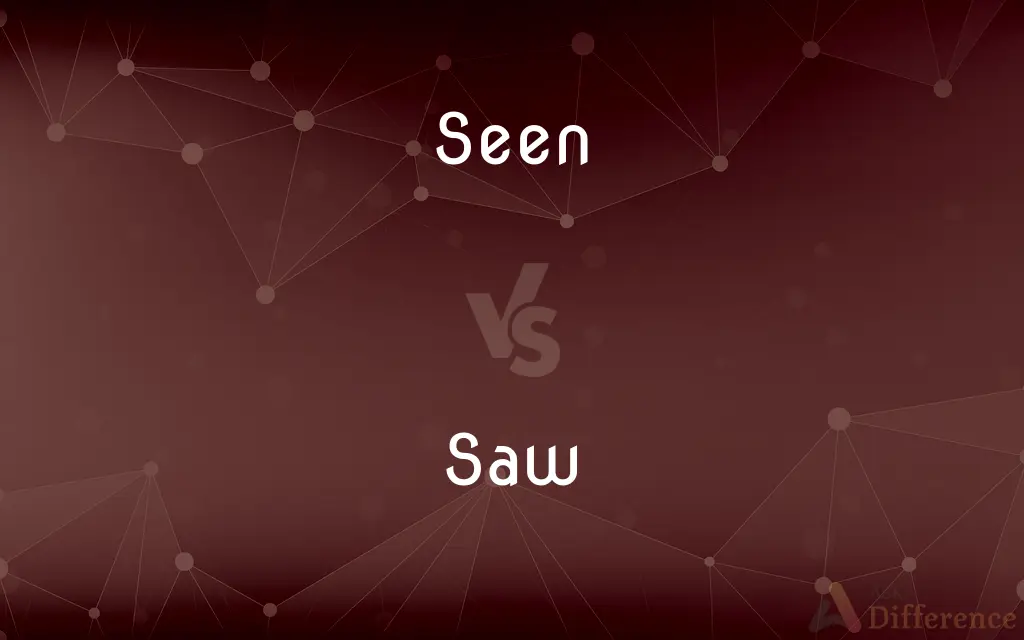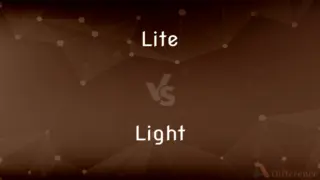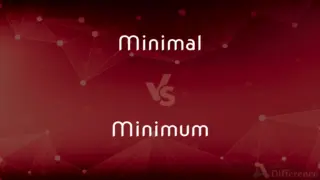Seen vs. Saw — What's the Difference?
Edited by Tayyaba Rehman — By Fiza Rafique — Updated on October 12, 2023
"Seen" is the past participle of "see," requiring an auxiliary verb, while "Saw" is the simple past tense of "see."

Difference Between Seen and Saw
Table of Contents
ADVERTISEMENT
Key Differences
"Seen" and "Saw" are both forms of the verb "see," but they are used in different grammatical structures. "Saw" is the simple past tense, used to describe actions that took place and were completed in the past. For instance, "I saw a movie yesterday." On the other hand, "Seen" is the past participle form and always requires an auxiliary verb like "have" or "has." An example would be, "I have seen that movie before."
The choice between "Seen" and "Saw" is determined by the structure of the sentence and the intended meaning. For beginners in English, this difference can be a bit tricky, but remembering that "Seen" always requires an auxiliary can be helpful. In contrast, "Saw" stands on its own.
Comparison Chart
Grammatical Form
Past participle
Simple past tense
Requires Auxiliary
Yes (e.g., have, has)
No
Example Usage
"They have seen the Eiffel Tower."
"They saw the Eiffel Tower."
ADVERTISEMENT
Time Reference
Refers to actions in the past without specific timing
Refers to specific past actions
Sentence Structure
"Subject + have/has + seen"
"Subject + saw"
Compare with Definitions
Seen
Past participle of "see."
I have seen the error.
Saw
Simple past tense of "see."
I saw a shooting star.
Seen
Denotes passive observation in the past.
The incident was seen by many.
Saw
Describes a past visual experience.
We saw the Northern Lights last night.
Seen
Used with auxiliary verbs to form perfect tenses.
He has seen better days.
Saw
A saw is a tool consisting of a tough blade, wire, or chain with a hard toothed edge. It is used to cut through material, very often wood though sometimes metal or stone.
Seen
Used to describe something witnessed.
This is the best performance I've ever seen.
Saw
Any of various tools, either hand-operated or power-driven, having a thin metal blade or disk with a sharp, usually toothed edge, used for cutting wood, metal, or other hard materials.
Seen
Indicates a past experience.
They've seen it all.
Saw
A familiar saying, especially one that has become trite through repetition.
Seen
Past participle of see1.
Saw
To cut or divide with a saw.
Seen
Past participle of see
Saw
To produce or shape with a saw
Sawed a hole in the board.
Seen
; saw.
I seen it with my own eyes.
Saw
To make back-and-forth motions through or on
A speaker who saws the air with his arms.
Seen
(Jamaica) To understand, to comprehend.
Everything irie, seen?
Saw
To use a saw
Sawing along the chalk line.
Seen
The letter س in the Arabic script.
Saw
To undergo cutting with a saw
Pine wood saws easily.
Seen
Versed; skilled; accomplished.
Well seen in every science that mote be.
Noble Boyle, not less in nature seen,Than his great brother read in states and men.
Saw
Past tense of see1.
Saw
A tool with a toothed blade used for cutting hard substances, in particular wood or metal.
Saw
Such a tool with an abrasive coating instead of teeth.
Saw
A musical saw.
Saw
A sawtooth wave.
Saw
(obsolete) Something spoken; speech, discourse.
Saw
(archaic) A saying or proverb.
Old saw
Saw
(obsolete) Opinion, idea, belief.
Saw
(obsolete) Proposal, suggestion; possibility.
Saw
(obsolete) Dictate; command; decree.
Saw
(transitive) To cut (something) with a saw.
Saw
(intransitive) To make a motion back and forth similar to cutting something with a saw.
Saw
(intransitive) To be cut with a saw.
The timber saws smoothly.
Saw
(transitive) To form or produce (something) by cutting with a saw.
To saw boards or planks (i.e. to saw logs or timber into boards or planks)
To saw shingles
To saw out a panel
Saw
Something said; speech; discourse.
Saw
A saying; a proverb; a maxim.
His champions are the prophets and apostles,His weapons holy saws of sacred writ.
Saw
Dictate; command; decree.
[Love] rules the creatures by his powerful saw.
Saw
An instrument for cutting or dividing substances, as wood, iron, etc., consisting of a thin blade, or plate, of steel, with a series of sharp teeth on the edge, which remove successive portions of the material by cutting and tearing.
Saw
To cut with a saw; to separate with a saw; as, to saw timber or marble.
Saw
To form by cutting with a saw; as, to saw boards or planks, that is, to saw logs or timber into boards or planks; to saw shingles; to saw out a panel.
Saw
Also used figuratively; as, to saw the air.
Saw
To use a saw; to practice sawing; as, a man saws well.
Saw
To cut, as a saw; as, the saw or mill saws fast.
Saw
To be cut with a saw; as, the timber saws smoothly.
Saw
A condensed but memorable saying embodying some important fact of experience that is taken as true by many people
Saw
Hand tool having a toothed blade for cutting
Saw
A power tool for cutting wood
Saw
Cut with a saw;
Saw wood for the fireplace
Saw
Refers to a past, completed action.
She saw the entire series.
Saw
Indicates direct observation.
He saw the accident happen.
Saw
A cutting tool with a toothed blade.
He used a saw to cut the wood.
Common Curiosities
When do I use "Seen" vs. "Saw"?
Use "Saw" for simple past actions and "Seen" with an auxiliary for perfect tenses.
What is "Seen" in grammatical terms?
"Seen" is the past participle of the verb "see."
Is "Saw" the past tense of "see"?
Yes, "Saw" is the simple past tense of "see."
Is it right to say "She has saw"?
No, the correct form is "She has seen."
Can I say "They seen the game"?
No, it should be "They saw the game" or "They have seen the game."
Which is the base form of both "Seen" and "Saw"?
The base form is "see."
Is "Saw" used for specific past events?
Yes, "Saw" refers to specific past actions or events.
Can I say "I seen a movie"?
No, the correct form is "I saw a movie" or "I have seen a movie."
Why is it "I have seen" and not "I have saw"?
"Seen" is the past participle form used with auxiliary verbs like "have."
What is the function of "Saw" in a sentence?
"Saw" functions as the main verb in the simple past tense.
Can "Saw" also mean a tool?
Yes, a "saw" is a tool with a toothed blade used for cutting.
Which is correct: "He seen" or "He saw"?
"He saw" is correct.
Do I always need an auxiliary verb with "Seen"?
Yes, "Seen" always requires an auxiliary verb like "have" or "has."
Is "I had seen" a correct usage?
Yes, it's the past perfect tense of "see."
Is "Seen" used for nonspecific past events?
Yes, "Seen" refers to past actions without a specific timing when used in perfect tenses.
Share Your Discovery

Previous Comparison
Lite vs. Light
Next Comparison
Minimal vs. MinimumAuthor Spotlight
Written by
Fiza RafiqueFiza Rafique is a skilled content writer at AskDifference.com, where she meticulously refines and enhances written pieces. Drawing from her vast editorial expertise, Fiza ensures clarity, accuracy, and precision in every article. Passionate about language, she continually seeks to elevate the quality of content for readers worldwide.
Edited by
Tayyaba RehmanTayyaba Rehman is a distinguished writer, currently serving as a primary contributor to askdifference.com. As a researcher in semantics and etymology, Tayyaba's passion for the complexity of languages and their distinctions has found a perfect home on the platform. Tayyaba delves into the intricacies of language, distinguishing between commonly confused words and phrases, thereby providing clarity for readers worldwide.














































